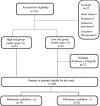Evaluation of the Diagnostic Role of Bedside Lung Ultrasonography in Patients with Suspected Pulmonary Embolism in the Emergency Department
- PMID: 28443595
- PMCID: PMC5615969
- DOI: 10.4274/balkanmedj.2016.1181
Evaluation of the Diagnostic Role of Bedside Lung Ultrasonography in Patients with Suspected Pulmonary Embolism in the Emergency Department
Abstract
Background: Despite the existence of detailed consensus guidelines, challenges remain regarding efficient, appropriate, and safe imaging methods for the diagnosis of suspected pulmonary embolism.
Aims: To investigate the role of the wedge sign, B-lines, and pleural effusion seen on bedside lung ultrasound in the diagnosis of pulmonary embolism.
Study design: Diagnostic accuracy study.
Methods: During the first evaluation of patients with suspected pulmonary embolism, bedside lung ultrasound was performed, and the B-lines, wedge sign, and pleural effusion were investigated. Computed tomography angiography was used as a confirmatory test and was compared with the lung ultrasound findings.
Results: Pulmonary embolism was detected in 38 (38%) patients. In the comparison of bedside lung ultrasound results, statistically significant differences were found between the groups in terms of the B-lines and wedge sign (p=0.005 and p>0.001, respectively). There were no significant differences in terms of effusion (p=0.234). Comparison of these findings with computed tomography angiography of the chest showed weak negative correlations between the groups in terms of B-lines (r=-0297) and a moderately positive correlation in terms of the wedge sign (r=0.523). The sensitivity, specificity, and positive and negative predictive values of lung ultrasound findings alone were low. In the logistic regression analysis, the wedge sign (p>0.01, OR=69.45, 95% CI=6.94-695.17) and B-line (p=0.033, OR=1.96, 95% CI=0.41-8.40) were found to be effective in the diagnosis of pulmonary embolism.
Conclusion: Although the role of lung ultrasound has been increasing in the management of critically ill patients, its value is limited and cannot replace the gold standard tests in the diagnosis of pulmonary embolism.
Keywords: Pulmonary embolism; diagnostic ultrasound; emergency departments bedside testing.; ultrasonography.
Conflict of interest statement
Similar articles
-
Acute pulmonary thromboembolism in emergency room: gray-scale versus color doppler ultrasound evaluation.Clin Respir J. 2018 Feb;12(2):474-482. doi: 10.1111/crj.12547. Epub 2016 Sep 27. Clin Respir J. 2018. PMID: 27608416
-
[The clinical value of bedside lung ultrasound in the diagnosis of chronic obstructive pulmonary disease and cardiac pulmonary edema].Zhonghua Wei Zhong Bing Ji Jiu Yi Xue. 2014 Aug;26(8):558-62. doi: 10.3760/cma.j.issn.2095-4352.2014.08.007. Zhonghua Wei Zhong Bing Ji Jiu Yi Xue. 2014. PMID: 25124904 Chinese.
-
Lung ultrasound for diagnosis of pneumonia in emergency department.Intern Emerg Med. 2015 Oct;10(7):851-4. doi: 10.1007/s11739-015-1297-2. Epub 2015 Sep 7. Intern Emerg Med. 2015. PMID: 26345533
-
Point-of-Care Lung Ultrasound in Critically ill Patients.Rev Recent Clin Trials. 2018 Jan 31;13(1):15-26. doi: 10.2174/1574887112666170911125750. Rev Recent Clin Trials. 2018. PMID: 28901850 Review.
-
Diagnostic accuracy of multi-organ point-of-care ultrasound for pulmonary embolism in critically ill patients: a systematic review and meta-analysis.Crit Care. 2025 Apr 23;29(1):162. doi: 10.1186/s13054-025-05359-x. Crit Care. 2025. PMID: 40269937 Free PMC article.
Cited by
-
Impact of Bedside Combined Cardiopulmonary Ultrasound on Etiological Diagnosis and Treatment of Acute Respiratory Failure in Critically Ill Patients.Indian J Crit Care Med. 2020 Nov;24(11):1062-1070. doi: 10.5005/jp-journals-10071-23661. Indian J Crit Care Med. 2020. PMID: 33384512 Free PMC article.
-
Association between Mid-Term Functionality and Clinical Severity in Patients Hospitalized for Pulmonary Embolism.Healthcare (Basel). 2024 Jul 2;12(13):1323. doi: 10.3390/healthcare12131323. Healthcare (Basel). 2024. PMID: 38998858 Free PMC article.
-
Polish recommendations for lung ultrasound in internal medicine (POLLUS-IM).J Ultrason. 2018;18(74):198-206. doi: 10.15557/JoU.2018.0030. J Ultrason. 2018. PMID: 30451402 Free PMC article.
-
Recommendations for Lung Ultrasound in Internal Medicine.Diagnostics (Basel). 2020 Aug 16;10(8):597. doi: 10.3390/diagnostics10080597. Diagnostics (Basel). 2020. PMID: 32824302 Free PMC article.
References
-
- Reissig A, Kroegel C. Transthoracic ultrasound of lung and pleura in the diagnosis of pulmonary embolism: a novel non-invasive bedside approach. Respiration. 2003;70:441–52. - PubMed
-
- Barillari A, Fioretti M. Lung ultrasound: a new tool for the emergency physician. Intern Emerg Med. 2010;5:335–40. - PubMed
-
- Joyner CR, Jr, Miller LD, Dudrick SJ, Eskin DJ, Knight DH. Reflected ultrasound in the detection of pulmonary embolism. Trans Assoc Am Physicians. 1966;79:262–77. - PubMed
MeSH terms
LinkOut - more resources
Full Text Sources
Other Literature Sources
Medical

